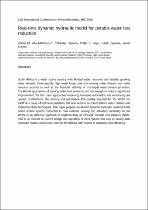JavaScript is disabled for your browser. Some features of this site may not work without it.
- ResearchSpace
- →
- Research Publications/Outputs
- →
- Conference Publications
- →
- View Item
| dc.contributor.author |
Abu-Mahfouz, Adnan MI

|
|
| dc.contributor.author |
Hamama, Y

|
|
| dc.contributor.author |
Page, Philip R

|
|
| dc.contributor.author |
Djouani, K

|
|
| dc.contributor.author |
Kurien, A

|
|
| dc.date.accessioned | 2017-02-23T10:04:58Z | |
| dc.date.available | 2017-02-23T10:04:58Z | |
| dc.date.issued | 2016-08 | |
| dc.identifier.citation | Abu-Mahfouz, A.M.I., Hamama, Y., Page, P.R., Djouani, K. and Kurien, A. 2016. Real-time dynamic hydraulic model for potable water loss reduction. In: 12th International Conference on Hydroinformatics (HIC 2016), Smart Water for the Future, 21-26 August 2016, Incheon, South Korea | en_US |
| dc.identifier.uri | http://www.sciencedirect.com/science/article/pii/S187770581631815X | |
| dc.identifier.uri | http://hdl.handle.net/10204/8981 | |
| dc.description | 12th International Conference on Hydroinformatics (HIC 2016), Smart Water for the Future, 21-26 August 2016, Incheon, South Korea | en_US |
| dc.description.abstract | South Africa is a water scarce country with limited water resources and steadily growing water demand. Unacceptably high water losses and non-revenue water threaten our water resource security as well as the financial viability of municipal water service provision. Traditional approaches of solving water loss problems are not enough to make a significant improvement; for this, new approaches involving increased automation and monitoring are needed. Furthermore, the sensory and automation ICT-overlay required for the WDN can itself be a cause of technical problems that also need to be solved before water utilities will implement these techniques. This paper propose a real-time dynamic hydraulic model (DHM) based control system connected to near realtime sensing and actuation capability on the WDN as an effective approach to implementing an efficient, reliable and adaptive WDN. This is in contrast to current design and operation of most WDNs that rely on steady-state hydraulic models which have inherent limitations with respect to reliability and efficiency. | en_US |
| dc.language.iso | en | en_US |
| dc.publisher | Elsevier | en_US |
| dc.relation.ispartofseries | Wokflow;17902 | |
| dc.subject | Active network management | en_US |
| dc.subject | Data imputation | en_US |
| dc.subject | Demand prediction | en_US |
| dc.subject | Dynamic hydraulic model | en_US |
| dc.subject | Leakage detection | en_US |
| dc.subject | Non-revenue water | en_US |
| dc.subject | Pressure management | en_US |
| dc.subject | Smart water network | en_US |
| dc.subject | Water loss | en_US |
| dc.subject | Wireless sensor network | en_US |
| dc.title | Real-time dynamic hydraulic model for potable water loss reduction | en_US |
| dc.type | Conference Presentation | en_US |
| dc.identifier.apacitation | Abu-Mahfouz, A. M., Hamama, Y., Page, P. R., Djouani, K., & Kurien, A. (2016). Real-time dynamic hydraulic model for potable water loss reduction. Elsevier. http://hdl.handle.net/10204/8981 | en_ZA |
| dc.identifier.chicagocitation | Abu-Mahfouz, Adnan MI, Y Hamama, Philip R Page, K Djouani, and A Kurien. "Real-time dynamic hydraulic model for potable water loss reduction." (2016): http://hdl.handle.net/10204/8981 | en_ZA |
| dc.identifier.vancouvercitation | Abu-Mahfouz AM, Hamama Y, Page PR, Djouani K, Kurien A, Real-time dynamic hydraulic model for potable water loss reduction; Elsevier; 2016. http://hdl.handle.net/10204/8981 . | en_ZA |
| dc.identifier.ris | TY - Conference Presentation AU - Abu-Mahfouz, Adnan MI AU - Hamama, Y AU - Page, Philip R AU - Djouani, K AU - Kurien, A AB - South Africa is a water scarce country with limited water resources and steadily growing water demand. Unacceptably high water losses and non-revenue water threaten our water resource security as well as the financial viability of municipal water service provision. Traditional approaches of solving water loss problems are not enough to make a significant improvement; for this, new approaches involving increased automation and monitoring are needed. Furthermore, the sensory and automation ICT-overlay required for the WDN can itself be a cause of technical problems that also need to be solved before water utilities will implement these techniques. This paper propose a real-time dynamic hydraulic model (DHM) based control system connected to near realtime sensing and actuation capability on the WDN as an effective approach to implementing an efficient, reliable and adaptive WDN. This is in contrast to current design and operation of most WDNs that rely on steady-state hydraulic models which have inherent limitations with respect to reliability and efficiency. DA - 2016-08 DB - ResearchSpace DP - CSIR KW - Active network management KW - Data imputation KW - Demand prediction KW - Dynamic hydraulic model KW - Leakage detection KW - Non-revenue water KW - Pressure management KW - Smart water network KW - Water loss KW - Wireless sensor network LK - https://researchspace.csir.co.za PY - 2016 T1 - Real-time dynamic hydraulic model for potable water loss reduction TI - Real-time dynamic hydraulic model for potable water loss reduction UR - http://hdl.handle.net/10204/8981 ER - | en_ZA |






